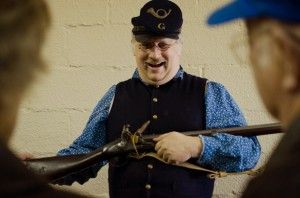Civil War influenced modern medicine

February 13, 2012
More Civil War soldiers died from disease than from battlefield injuries, but advancements made in sanitation, trauma surgery and disease treatment during the conflict revolutionized medicine in the following decades.
At the start of the Civil War, doctors used medical practices dating back to the previous century, said Judy Rhine, an exhibitor at the “Civil War Weekend of Union County,” which was at the Anna Arts Center Friday, Saturday and Sunday.
The outdated medical practices contributed to the high mortality rate.
Advertisement
“The Civil War is when medicine really changed,” Rhine said.
Lee Hackney, the event organizer from Promoting Appreciation of Structural Treasures of Union County, said volunteers organized more than 20 events, including a Civil War-era gun collection, memorabilia from the presidential elections of Abraham Lincoln and Ulysses S. Grant, speakers and a musical performance of “Lincoln: The Life and Times.”
Rhine is a member of the Rock Ridge Muzzleloaders, a Revolutionary and Civil War reenactment group that displayed a Civil War memorabilia exhibit during the event. At Rhine’s exhibit, visitors examined some of the surgical tools used during the mid-1800s while they listened to her speak about how both Union and Confederate troops suffered during the war.
Doctors were just beginning to learn about germs and they didn’t understand disease transmition, Rhine said. She said many still believed in “bad humors,” a medical theory from medieval times that suggested disease was caused by imbalances of blood, bile and phlegm in the human body.
“They didn’t know to separate sick people from the wounded people,” Rhine said.
She said many recruits came from isolated towns and had no immunity to measles, mumps and chicken pox. These diseases spread rapidly in the confined quarters of the camps.
The United States had few well-trained physicians at the beginning of the Civil War, Rhine said. Most doctors were trained as apprentices rather than at medical schools. They had little experience with trauma injuries and internal surgeries but learned quickly in makeshift surgical wards, she said.
Advertisement*
During the Civil War, bleeding was still a common practice.
“They would bleed you until you turned gray,” Rhine said as she picked up a worn metal bleeding bowl and pointed to an indentation where soldiers would rest their arms while being bled.
She said doctors believed that purging tainted blood would rid a body of disease.
In addition to bleeding, substances now known to be toxic, such as mercury and strychnine, were used to treat dysentery.
“It’s a wonder anybody lived,” Rhine said.
The number of amputations performed on injured soldiers during the Civil War was high, Rhine said. Poor medical treatment following an amputation often led to a soldier’s death.
Jay Rossberg, another member of the Rock Ridge Muzzleloaders, said the use of a new type of bullet, the Minié ball, during the Civil War was one reason for the increased number of amputations from previous wars.
Developed by a French Army officer in the 1840s, the Minié ball had a hollow base that would expand when gases were released by the igniting gunpowder, Rossberg said. Minié balls shattered bones and destroyed muscles and ligaments, he said.
Rhine said what doctors learned during the four-year war about sanitation, trauma and disease became the basis for modern medicine.
She said doctors began to discover how diseases were transmitted and how improving sanitation would prevent epidemics. Doctors became highly skilled at trauma care because of the number of surgeries they performed.
“At the beginning of the Civil War, there weren’t many trained physicians on either side. After four years, they learned a lot.”
Advertisement








